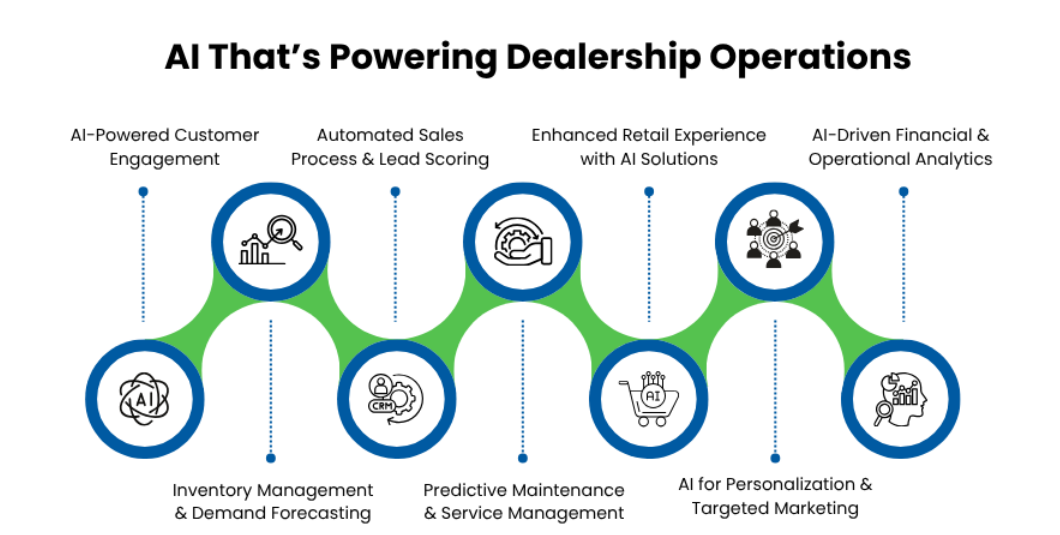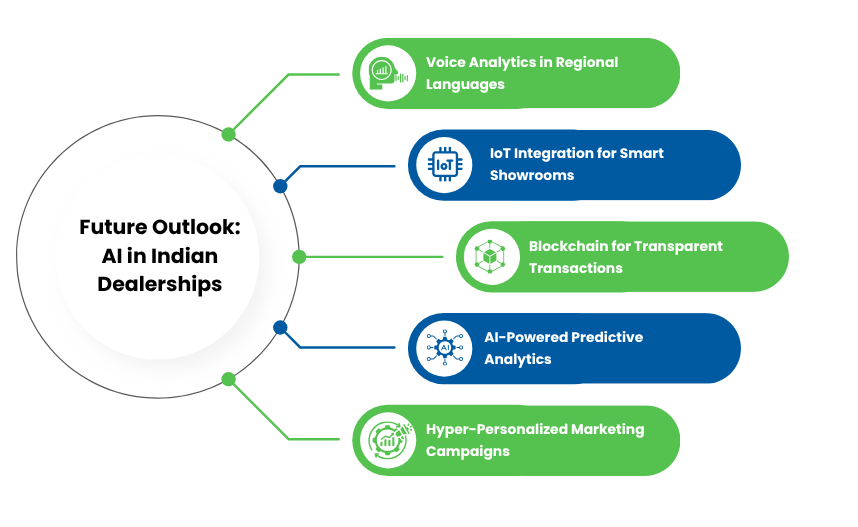India’s OEMs and dealership networks are facing big challenges. These include high costs for keeping cars in stock, changing customer needs, and tough competition. AI-powered analytics is a new tool that can help. It uses smart technology to make dealership networks work better. In areas like tractors, electric vehicles (EVs), and commercial vehicles, AI tools are very important. They help make operations smoother and keep customers happy.
From smart inventory management in automotive to predictive analytics for dealership networks, this tech is helping teams stay ahead. The bigger picture? Dealership network operations optimization is now tied directly to how well OEMs use AI. These changes reflect the broader Indian auto industry AI trends, and if you’re an OEM not exploring Automotive AI in India, you’re already behind.
This blog will show how AI can help OEMs solve problems, improve work, make customers happy, and earn more money in 2025.
Discover how NetFlows360 can change your dealership network’s future.
The Current State of the Indian Automotive Industry
India’s car market is very big and different. In cities, people like premium sedans. In villages, they prefer utility vehicles (UVs) and tractors. OEMs must plan their dealership networks to match these different needs. Customers in different areas want different things, and their buying habits change with the seasons.
| Segment | Company | Market Share (2024) | Units Sold / Target | Source |
| Tractor Market | Mahindra & Mahindra | Over 40% | 400,000+ tractors | FY 2024‑25 domestic |
| EV Market | Tata Motors | 62% | Not specified | Reuters |
| EV Market | Mahindra (EV) | Not specified | 30% growth targeted by 2027 | Company announcement |
As the market changes with more EVs and smart farming tools (like AI-powered tractors), OEMs need to use digital tools. AI can help predict what customers want, manage stock better, and stay ahead of competitors.
Core AI Analytics Applications for OEMs
India’s car industry was worth about ₹20 lakh crore (USD 240 billion) in 2024. Passenger vehicle sales reached 4.3 million units in FY 2024-25, up 2% from last year. Two-wheeler sales grew by 9.1%, with 19.6 million units sold (Source: SIAM, 2024). Here are the main ways AI can help OEMs:

- Smart Inventory Management & Demand Forecasting: AI helps predict what customers will buy. It looks at local needs, money matters, and even weather. This helps OEMs keep the right number of tractors, EVs, and commercial vehicles in stock. It stops overstocking or running out of stock.
- AI-Powered Customer Engagement: AI tools like virtual avatars and chatbots help talk to customers. Using platforms like NetFlows360, OEMs can answer questions fast, suggest products, and turn more leads into sales.
- Predictive Maintenance & Service Management: AI can guess when vehicles or machines need repairs. This reduces breakdowns for tractors and EVs, improves service, and makes customers happy.
- Automated Sales Process & Lead Scoring: AI checks customer data and picks the best leads. This helps OEMs focus on people most likely to buy. For expensive items like tractors or EVs, AI can make special offers to close deals.
- AI for Personalisation & Targeted Marketing : AI studies customer behaviour to create ads that match their needs. OEMs can send the right ads for EVs, farm equipment, or luxury cars at the right time.
- Enhanced Retail Experience with AI-Powered Solutions: AI tools like chatbots make shopping easy and fun. They help customers trust the dealership and buy more.
- AI-Driven Financial & Operational Analytics: AI works with ERP systems to manage money better. It helps OEMs see how dealership networks are doing, set prices, and save costs.
Explore NetFlows360 to make your dealership network better.
Implementation Roadmap for Indian OEMs
The road to AI implementation for OEMs and dealerships in India can be broken into clear phases:
Phase 1: Foundation (Months 1-2)
- Data Infrastructure: Many OEMs work with siloed data systems. Establishing a unified data infrastructure is key to integrating AI.
- AI Tool Training: Staff training is essential to ensure employees are proficient in using AI tools.
- Quick Wins: Early successes like faster lead response times or more accurate inventory forecasts will build confidence in AI systems.
Phase 2: Core Analytics (Months 3-4)
- Implement Core Features: Start with key features like inventory optimisation and customer segmentation to drive immediate results.
- Real-Time Dashboards: Deploy performance dashboards to track key metrics such as lead scoring and sales status.
Phase 3: Advanced Intelligence (Months 5-6)
- Predictive Analytics: Advanced AI features will provide more accurate sales forecasts, optimal pricing strategies, and inventory recommendations.
- Personalised Recommendations: AI will analyse customer data to recommend actions, such as upselling or cross-selling opportunities.
AI-Powered Analytics: Real Results from the Ground
AI is no longer just a buzzword in India’s auto world. It’s already working quietly behind the scenes to solve real dealership network problems like stock delays, low sales, and poor customer service.
Mahindra & Mahindra
Mahindra is using AI-powered dealership analytics to make its sales team smarter. Their dealers now get help with understanding which customers are ready to buy and when. This has made sales conversations smoother and faster. They’re also managing vehicle stock better by using predictive analytics for dealership networks, so they don’t end up overstocked or out of popular models.
Tata Motors
Tata has added AI to their EV dealership network to offer better service. Customers are guided with the help of AI tools that remember their preferences and suggest the right model or service option. This has helped improve trust and brought more repeat buyers to Tata showrooms.
Escorts Kubota
Escorts dealers were struggling with slow-moving stock. AI fixed that. Smart inventory management in automotive helped them understand what was needed, where, and in what quantity. This made sure tractors weren’t just sitting in yards but moving quickly to customers.
John Deere India
John Deere used automotive AI in India to improve service for farmers. With predictive tools, they could tell when a tractor might need repairs before it even broke down. This helped farmers avoid delays and built strong loyalty with the brand.
Hero MotoCorp
Hero turned to AI for marketing and stock management. Instead of using the same message for everyone, their system sends different offers to different buyers, based on what they’ve shown interest in. This level of personalisation helped them reduce waste and improve dealership network operations optimisation.
And What About You?
If your dealership network is still using old-school systems, AI can help. Tools like NetFlows360 are built to plug into your existing setup and make everything from lead handling to inventory much more efficient. OEMs using smart systems are already ahead. Don’t wait to catch up.
Overcoming the Real Challenges of AI
Using AI sounds exciting, but it comes with its own set of challenges. For Indian OEMs and dealership networks, the good news is that most of these can be solved with simple, step-by-step planning.
1. Old Systems and Internet Woes
Many OEMs, especially in smaller cities, are still using outdated software and face patchy internet. This makes it hard to run anything advanced. That’s where cloud-based AI solutions come in. Platforms like NetFlows360 don’t need heavy hardware. Just a stable connection and a smartphone or laptop, and your team is ready to use AI without any big investment.
2. Teams That Are Not Tech-Ready
AI tools won’t help much if the people using them don’t feel confident. A lot of dealership networks aren’t familiar with digital dashboards or automated reports. The fix? OEMs need to offer training not with technical jargon, but with real examples from the shop floor. Once workers see that AI makes their work easier (not harder), they’ll start using it naturally.
3. Fear of Change
Let’s face it, no one likes changing how they work. Some sales staff may prefer notebooks and calls over dashboards and alerts. That’s okay. Start small. Use AI tools to solve one pain point, like faster lead follow-ups or better daily reporting. Once the team sees early wins, the rest will follow.
4. Budget Concerns
Many OEMs worry that AI is only for premium brands or big metros. But that’s changing. Today, you can start small with affordable subscription models or pay-as-you-grow options. A phased rollout helps you manage cost and test what works before going all in.
5. Data Privacy and Compliance
AI runs on data, and data needs protection. Dealership networks collect names, contact details, purchase history, and more. To build trust, OEMs must choose systems that follow Indian privacy rules like the Digital Personal Data Protection Act, 2023. Tools like NetFlows360 already meet these standards and have built-in security. Make sure your team knows how to handle data safely, too.
By fixing these five key issues, OEMs can unlock the real value of AI in the auto industry by 2025. And the best part? Once the basics are in place, AI starts delivering results that are both visible and lasting.
What’s Coming Next: AI Trends in Indian Dealership Networks
AI isn’t just about dashboards and reports. It’s becoming a part of everyday life, from how customers talk to brands to how salespeople close deals. Here are a few big Indian auto industry AI trends that OEMs should get ready for:

1. Talk in the Customer’s Language
Voice-based AI is getting smarter. Soon, customers will be able to ask questions in Hindi, Tamil, Marathi, or Bengali and get clear, helpful answers. Whether they’re asking about tractor financing or the nearest EV charging point, AI will handle it. This will make rural and regional dealership networks feel more local and more human.
2. Smart Showrooms with IoT
Imagine a test drive that starts with a sensor and ends with a personalised video message. That’s where IoT and AI are heading. Smart displays will track what each customer looks at, and AI will use that info to offer the right model, the right time for a follow-up, or even the right EMI plan. These showroom experiences will feel modern and personal, not mechanical.
3. Clear, Trustworthy Deals with Blockchain
Warranty claims, service history, loyalty points, all can be tracked and automated using blockchain. For example, if a tractor breaks down, a smart contract could process the warranty without paperwork or follow-ups. It saves time and builds trust between OEMs, dealers, and customers.
4. Better Forecasting with Predictive Tools
AI won’t just say “what happened,” it will tell you what’s coming. If EV demand spikes in Bengaluru next quarter, or if farmers in Punjab delay purchases due to weather, predictive analytics for dealership networks will help you prepare in advance. This means better stocking, smarter marketing, and fewer last-minute headaches.
5. Targeted Marketing, Done Right
Instead of showing everyone the same ad, AI will send different messages to different people. A customer searching online for premium scooters will get a test ride offer nearby. Someone browsing EV savings tips might get a calculator showing their fuel cost drop. Personalised marketing works better, and AI makes it automatic.
6. Showroom at Home with AR
With Augmented Reality, buyers can check out a new SUV or tractor from their living room. A quick scan with a phone brings the vehicle to life in 3D, spin it, open doors, change colours. This is great for remote buyers or busy customers, and it brings a “wow” factor to every sale.
7. Greener Dealership Networks with Smarter Tools
As India moves toward EV adoption, OEMs can use AI to support green goals. Whether it’s suggesting eco-friendly models, managing battery swaps, or offering savings estimates, AI tools can push your brand ahead in the race for sustainability.
Wrapping Up
If you’re an OEM waiting for the “right time” to start using AI-powered dealership analytics, here’s the thing: that time is already here. The market is changing fast. Customers expect better service, faster responses, and smarter offers. OEMs need systems that help them deliver all of that without burning out their teams.
With tools like NetFlows360, you don’t have to build anything from scratch. You just plug in, train your team, and start solving real problems.
Ready to optimise your dealer network?
Request a demo and see how AI can change the game for your brand.
Frequently Asked Questions(FAQs)
Because it directly affects how your brand is sold on the ground. If your dealers don’t know what to stock, when to follow up, or how to handle leads properly, you lose business. AI gives them smarter tools so they’re not running blind. And when your dealers do better, your numbers go up too.
Stocking the same vehicles everywhere doesn’t work in India. What sells in Coimbatore may not sell in Kanpur. AI studies local demand patterns and helps dealers decide what to keep ready. That way, you avoid slow-moving inventory and make sure buyers get what they want, fast.
Yes. When you give your dealers tools that reduce their daily stress, like better lead tracking, faster reporting, or alerts for low stock, they trust your systems more. AI doesn’t just support operations; it builds stronger loyalty between OEMs and their dealers because it shows you care about their growth too.
That’s common. Many teams are used to working a certain way. The solution is to start with simple tools, maybe just smart dashboards or better reporting, and show quick wins. Once they see it saves time or helps close a deal, they’ll get on board. You don’t need to force a big change on day one.
Pick one pain point, like lead leakage or overstocking. Roll out a basic AI tool in just a few locations. Train those teams properly and track results. If it works well, expand slowly. Don’t treat it like an IT project. Treat it like an operations fix. That’s when adoption sticks.
